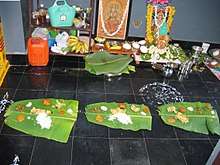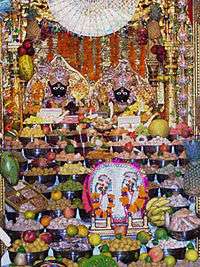Prasāda
Prasāda (Sanskrit pronunciation: [pɽɐsaːdɐ], Sanskrit: प्रसाद), variantly spelled as Prasadam, Prasad and Prasada, is a material substance of vegetarian food that is a religious offering in both Hinduism and Sikhism. It is normally consumed by worshippers after worship. Mahaprasada (also called Bhandara) in Hinduism, similar to the langar in Sikhism,[1] is the consecrated food offered to the deity in the temple which is then shared and eaten by the masses without discrimination.[2][3][4] Sometimes this vegetarian offering will exclude the prohibited items such as garlic, onion, roots, etc.[2]
.jpg)
Etymology

Prasāda is derived from the verb prasad which consists of the verb सद् (sad - to sit, dwell) which is prefixed with प्र (pra - before, afore, in front) and used as finite verb प्रसीदति (prasīdati - dwells, presides, pleases or favours etc). 'Prasada' literally means a gracious gift. It denotes anything, typically an edible food, that is first offered to a deity, saint, Perfect Master or an avatar, and then distributed in His or Her name to their followers or others as a good sign.[5]
Various meanings

As a spiritual state prasāda has a rich history of meanings in the Sanskrit tradition from Vedic literature onwards. In this textual tradition, prasada is a mental state experienced by gods, sages, and other powerful beings and is marked by spontaneous generosity and the bestowing of boons. In the earliest literature (Rig Veda) onwards Prasāda is understood in this sense of a mental state, not as an aspect of ritual practice. In later texts such as the Shiva Purana, references to prasada as a material substance begins to appear alongside this older meaning.. Prasada is also the companion emotion to samvega (the emotion Siddartha felt on his first encounter with aging, illness, and death). Prasada is the emotion Siddartha felt on encountering the forest sramana: "a clear sense of serene confidence that one has found the way out" (Robinson, p. 7, 2005). Samvega stirs up the mind whereas prasada makes it calm. The two emotions provide a proper balance of each other: "samvega keeps prasada grounded in reality; prasada keeps samvega from turning into hopelessness" (ibid.)
In its material sense, prasada is created by a process of giving and receiving between a human devotee and the divine god. For example, a devotee makes an offering of a material substance such as flowers, fruits, or sweets — which is called naivedya. The deity then 'enjoys' or tastes a bit of the offering, which is then temporarily known as bhogya. This now-divinely invested substance is called prasāda and is received by the devotee to be ingested, worn, etc. It may be the same material that was originally offered or material offered by others and then re-distributed to other devotees. In many temples, several kinds of prasada (e.g., nuts, sweets) are distributed to the devotees.
Practices
Some strict Gaudiya Vaishnavas, most commonly initiated ISKCON devotees, will eat only prasadam, i.e., everything they eat is first offered to Krishna, not simply a few items as with most other Hindus. In addition, the cooking of prasadam is done without tasting, because it is not for the believer's own consumption, but to offer to Krishna — they will receive the remnants of Krishna's food, which they consider to be NON-different to Krishna. ISKCON temples are known for providing free prasada meals to all who come, as they believe that this is not only feeding the poor but providing them with Krishna's mercy as well.[6][7]
One way that prasadam is commonly prepared is to place the food in offering before an image or deity of the spiritual figure to be honored, sometimes on a plate or serving vessel reserved only for spiritual purposes; and only then, after some time is allowed to pass, does the food become holy prasadam for further distribution.
In Sikhism, parshad is served to the congregation after prayer without worship of a polytheistic deity. Parshad represents the same values as langar in that it is served indiscriminatory.
See also
References
- Pashaura Singh, Louis E. Fenech, 2014, The Oxford Handbook of Sikh Studies
- Chitrita Banerji, 2010, Eating India: Exploring the Food and Culture of the Land of Spices.
- Subhakanta Behera, 2002, Construction of an identity discourse: Oriya literature and the Jagannath cult (1866-1936), p140-177.
- Susan Pattinson, 2011, The Final Journey: Complete Hospice Care for the Departing Vaishnavas, pp.220.
- Natu, Bal, Glimpses of the God-Man, Meher Baba, Sheriar Press, 1987
- Bhagavad-Gita 3:13
- Bhagavad-Gita 9:27
External links
| Wikimedia Commons has media related to Prasad. |